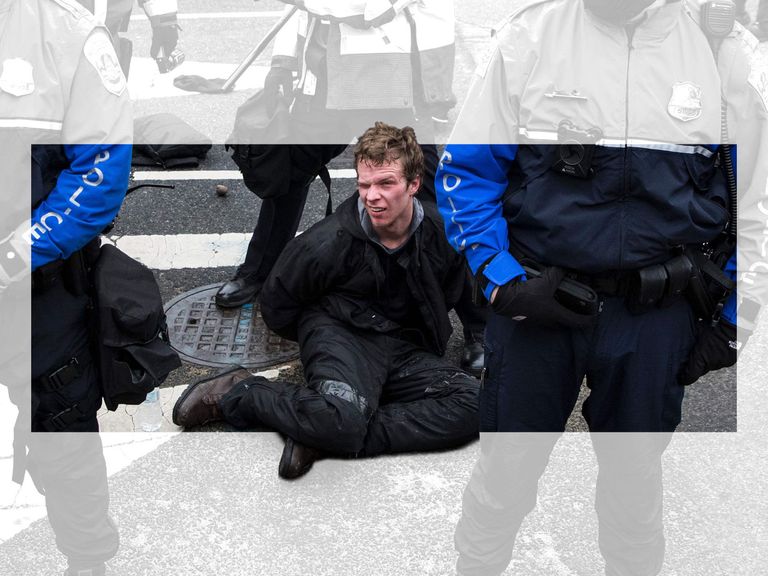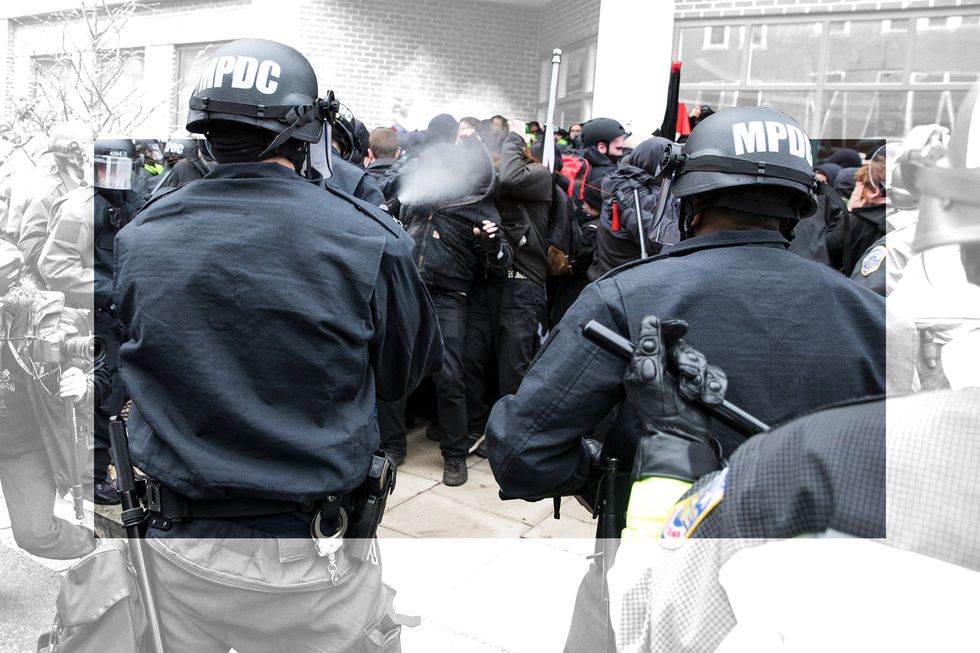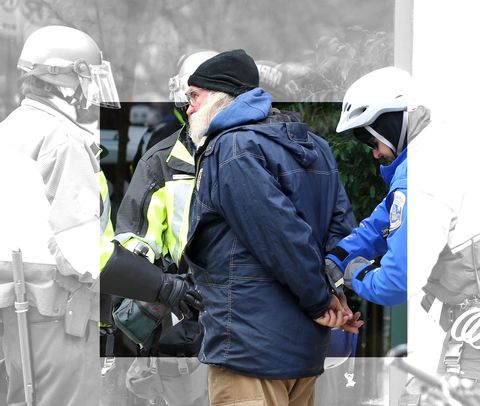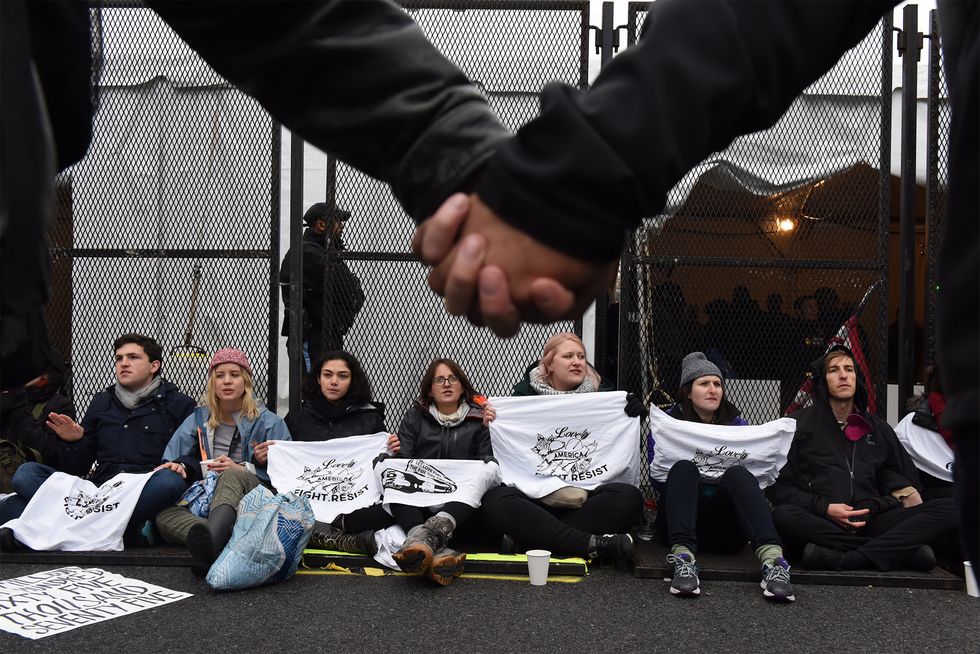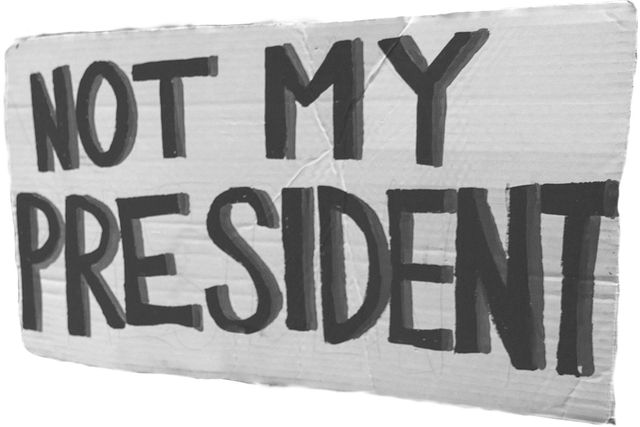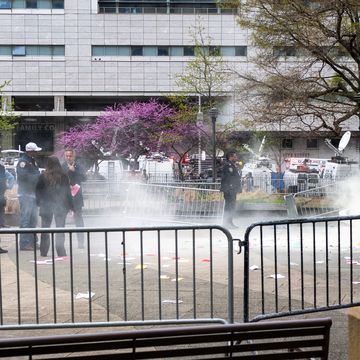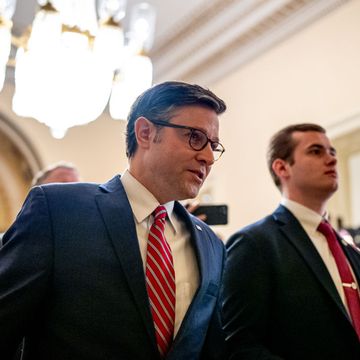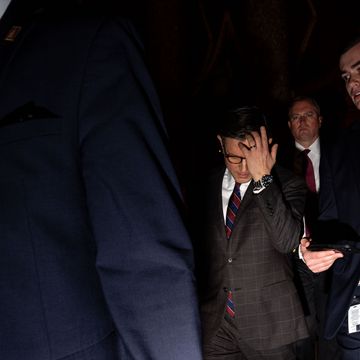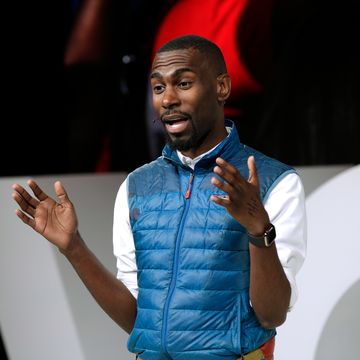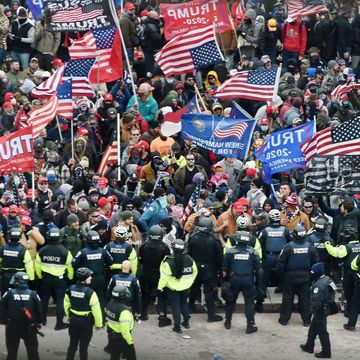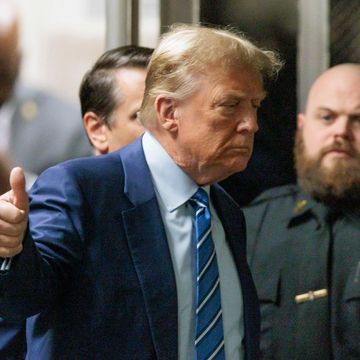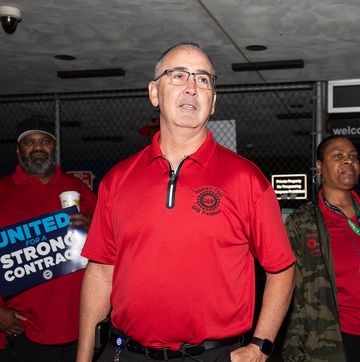"It's crazy, a few windows got smashed," 23-year-old Olivia Alsip said, two months after her arrest on felony riot charges. "Why are 214 people looking at ten years in prison?"
Alsip only knew one other person at the protest march that day. The political science graduate student from the University of Chicago had met her partner in November, when the two had joined the camps at Standing Rock opposing the Dakota Access Pipeline. When they heard about calls to protest Donald J. Trump's inauguration in D.C. on January 20th under the banner "Disrupt J20," they felt they had to be there. "I identify as an anarchist, and I've been an activist for women's and queer rights since the 8th grade," Alsip told me over the phone from Chicago.
Alsip is among 214 defendants facing felony riot charges, up to a decade in prison and a $25,000 fine for their participation in the anti-capitalist, anti-fascist march, which ended with a mass arrest on the morning of Inauguration Day. As far as the student understands, the evidence against her amounts to little more than proof of her presence at the unruly protest, as indicated by her arrest. Like the vast majority of her co-defendants, Alsip didn't break or throw anything. Now she lives in shock over the steep price she and her fellow protesters might pay as the new administration and police forces set the tone for how they will deal with the spike in organized dissent.
Anarchists and anti-fascist activists across the country have responded to Trump's ascendancy, and particularly the attendant emboldening of white supremacists, with confrontational protest. Rivers of digital ink were spilled approving and denouncing the meme-friendly punch delivered to neo-Nazi Richard Spencer, as well as the militant demonstrations that prevented far right troll Milo Yiannopoulos from waxing hateful at UC Berkeley. But while scattered vandalism and punching (a neo-Nazi) were deemed headline-grabbing militancy, the media relegated the most extreme incidents involving anarchists and antifascists—namely, recent treatment of them—to footnotes.
A New York Times article published two weeks after the inauguration about anarchist protests accorded just half a sentence to the fact that a Yiannopolous supporter in Seattle shot and seriously injured an anti-fascist activist, and has yet to face charges. Fifteen paragraphs down, a mere mention was given to the mass arrest of the 200-plus anti-fascist protesters on Inauguration Day. The fact that these arrestees now face felony riot charges went unmentioned by the Times—blanket charges, which carry a heft unheard of in the last decades of protest history.
"In my over thirty years of practicing law, I've never seen anything like this," said veteran D.C. attorney Mark Goldstone, of the charges. Goldstone, who has defended dozens of activist cases and is representing six of the J20 defendants, called the charges "unprecedented territory."
Dragnet arrests at protests are nothing new—recall the arrest of over 700 Occupy protesters on the Brooklyn Bridge. Nor is the leveling of serious criminal charges to demonstrators accused of property damage. With a legal logic seemingly opposite to that in the J20 cases, just one man was blamed for the $50,000 of property damage wrought during the 2009 Pittsburgh G20 Summit; he was convicted of felony criminal mischief and three misdemeanors. But the charge of felony riot is in itself rare, let alone when applied to over 200 people.
The charges all stem from the single mass arrest of protesters who had taken part in the Disrupt J20 march. It was a typical black bloc march, in which protesters mask their faces and wear all black. More than 500 participants gathered some two miles north of the inaugural parade route and surged southward, marching, chanting, and crowding the streets as an aesthetically united force. Whether illegal activity occurred in the context of the march is not in question. By the time D.C. Metropolitan police moved in with pepper spray and flash-bang grenades, a number of march participants were smashing windows–of banks, of chain restaurants, of a limo. Some pulled trash cans into the street, some set off handheld fireworks, and one cop was hit by a rock. Police filings claim that protesters damaged more than $100,000 worth of property that day (a figure that includes destruction caused after the mass arrest).
But no one—neither the police nor the government—suggests that that most or even many of the arrestees directly engaged in property destruction or violence. Nonetheless, the police department and the government maintain that not only was a dragnet arrest appropriate, but that the police had probable cause to believe that each and every of the more than 200 arrestees had "willfully incited or urged others to engage in the riot." On this point, the law is precise: Even in the case of an alleged riot, the police must have probable cause to arrest each and every individual.
"All the police officers were outstanding in the judgment that we used," Metropolitan Police Department interim chief Peter Newsham said the day after the inauguration, "I couldn't be more proud of the way this department responded." Mayor Muriel Bowser tweeted her support for "our officers as they handled crowds." But it is precisely police judgement that problematizes these riot charges.
The original arrestees included a handful of professional journalists, medics and legal observers, most of whom have since had their charges dropped. Of the remaining 214 arrestees, a handful of individuals also face property damage charges, having been allegedly identified smashing windows. One man, Alsip's partner, has been charged with felony assault on a police officer for allegedly throwing the rock that struck a cop; he was identified by his shoes.
As the pretrial court proceedings enter into the discovery phase, the prosecution's position is becoming clear: The evidence so far against numerous defendants amounts to no more than video footage of their continued presence in the march and their choice of black bloc attire. If the mass arrest was imprecise enough to sweep up journalists and legal observers, how can it be maintained that the police had probable cause to arrest every single other protester for rioting and inciting? If continued presence, proximity and black garb is sufficient for the necessary legal standard of individuated probable cause for arrest and prosecution under these charges, the D.C. police and the government have, from day one of Trump's presidency, lowered the standard for what it takes to turn a protester into a felon.
Mara Verheyden-Hilliard, the executive director of the Partnership for Civil Justice Fund, a legal organization that has long fought civil and human rights cases, expressed concern about police making dragnet mass arrests without particularized probable cause. She said that arrests "simply based on proximity or shared political views at a march" set a troubling precedent for all protests, not just anarchist marches. She explained that "it means at any demonstration," if a participant or a provocateur commits an illegal act, then "the entire demonstration can be subject to indiscriminate force and large groups of people can be suddenly arrested without notice or opportunity to disperse, and face life-altering charges."
Mass arrests, let alone with felony charges, have been rare in D.C. since 2002, when the then-assistant police chief Peter Newsham (the current interim police chief) ordered the arrest of roughly 400 people during an anti-World Bank/IMF demonstration in Pershing Park. The dragnet arrest included both peaceful protesters and bystanders walking to work, and led to years of litigation and an $8.25 million settlement on the part of the Justice Department and Department of the Interior. It also led to the establishment of policies and statutes governing protest policing and defending First Amendment activity in the capital. "From the first day of the Trump administration, Newsham and the police department have really stepped back in time," said Verheyden-Hilliard.
I had joined the march at its genesis at Logan's Circle, as participants tightened black bandanas around their faces and gathered in formation behind block-wide banners. I heard glass crack around us as we snaked through the city's wide boulevards, and some protesters peeled from formation to take a rock or a stick to a window. Chants common to contemporary U.S. protest boomed louder than any breaking glass: "No Trump, No KKK, No Fascist USA!" At no point did the police move in to grab individuals as they destroyed property, but after minutes that felt longer than they lasted, cops charged the group en masse.
After one group of protesters had broken through a police line on the intersection on L and 12th Street, cops penned in the remaining crowd of 230 and held them there for more than four hours before taking them into holding. In the chaos of charging police, wafting pepper spray, and scrambling protesters I had detached from the crowd just half a block before the cops closed in.
"When the police kettled us [corralled them into a net], they pushed us all into one big writhing mass with not enough room to stand," Alsip recalled. "When they stepped back, people were screaming and crying because they had just been maced or hit."
The government claims that First Amendment protections don't apply in the J20 cases because property damage began "from the jump" (i.e. immediately). The indictment states that protesters "did not exercise multiple opportunities to leave the Black Bloc," and cheered and chanted "fuck it up", "fuck capitalism" and "whose streets?" (Slogans that have peppered most every protest I've attended, from Occupy to environmental marches to Black Lives Matter.)
According to Verheyden-Hilliard, such a claim goes against 50 years of cases in which property damage or violence occurs during First Amendment activity. "The glue that holds this group together is First Amendment activity," she said. "The line that violence began 'from the jump' distracts from the fact that the police acted unlawfully, as we can see from the fact that the government is trying to extricate particularized probable cause after the fact."
At a pretrial status hearing I attended in March at the high modernist D.C. Superior Court building, assistant United States attorney Jennifer Kerkhoff told the court that the government had collected more than 600 hours of video footage and data pulled from more than 100 cell phones taken from the arrestees. She said that each defendant would be shown individuated evidence of their participation in the riot and its incitement. But on a late-March conference call with 15 other lawyers representing J20 clients, Goldstone learned that for a number of defendants this alleged evidence amounted to no more than, as he put it, "Here's your client at the beginning of the march, wearing black clothes and goggles, your client could have left but did not, and here is your client at the end, in the police kettle."
"The scary thing about it," said Goldstone, "is that defendants who want to test that theory have to be willing to face a jury, who could uphold the government's line." It's not hard to demonize a masked protester.
As such, while civil liberties groups and legal support groups stress police misconduct and prosecutorial overreach, the pressure for defendants to plead out is high. And if pleas are extracted from most defendants, the ability to bring civil litigation against the police department will be significantly diminished if not foreclosed. It's a predicament all too typical of the judicial process in this country, which threatens lengthy prison sentences to extract pleas out of court.
At the time of writing, just one defendant has taken a plea. Last week, an 18-year-old man pled guilty to one count of misdemeanor rioting or inciting to riot, a suspended 180-day sentence, one year of supervised probation, a $500 fine, and 50 hours of community service. Because he is under 23, the defendant was charged under the Youth Act, which allows for a young person who "will derive benefit" to get special treatment under the law. This would not apply to most every other arrestee, most of whom were between 25 and 40. "The plea deal that was accepted by one defendant was both a bad deal and irrelevant to everyone else's cases," the Dead City Legal Posse, a D.C. volunteer legal support group set up to assist the J20 cases, wrote in a statement.
The support group does not offer legal advice, but commented on perhaps the most salient information to come from the plea. "After the plea deal was accepted, the prosecutor is required to say what the government 'would have been able to prove'," the collective noted. According to the group, the government was only able to show the following: That the defendant joined a black bloc with 200 other people; marched with the black bloc for 30 minutes; Had multiple opportunities to leave and did not; Wore black and goggles; and, in the words of the prosecutor, "knew or reasonably should have known that the black bloc was causing destruction," and "the actions of the black bloc caused and constituted a riot."
This, the statement notes, "is literally all they had on him." As the cases against more and more defendants appear to rest on the same scant evidence, it doesn't take a defender of black bloc tactics to see a dangerous legal precedent quietly crystallizing. A possible 10 years in prison would be an extreme punishment for breaking windows. But the J20 cases are not an occasion to debate the moral or tactical merits and flaws of political property damage. How could it be? Most J20 defendants broke nothing at all.
Of the dozens of New York activists I know who traveled to D.C. to join the J20 protests and the vast but placid Women's March the following day, three were arrested in the kettle. In the week that followed the J20 arrests, the names and personal information—including some addresses of arrestees—were made public by far-right site GotNews.com, and the New Yorkers I spoke to claim to have received numerous online threats.
One 29-year-old Brooklyn-based protester told me that this sort of harassment highlights one impetus for deploying black bloc tactics in the first place—tactics that have grave implications for less seasoned dissenters. "Clearly, it was in the best interest of everyone present for the anti-fascist march on the day of my arrest to conceal their identities," he said, "because in the current climate in which we exist, the danger is very real."
But while the shock of felony charges, and the arduousness of a lengthy legal process weighs on the defendant, he told me that he has been surprised and heartened by the supportive attitude of some more mainstream anti-Trump protesters towards the black bloc.
He told me that following his release from jail on January 21st, he went with some friends to D.C. institution Ben's Chili Bowl. "We found quite a few pink pussy hat-wearing Women's March attendees inside," he said. He asked the women what they felt about the Richard Spencer punch and the J20 protests, expecting that they might repeat historic denunciations of "bad protesters." "To my surprise," he said the women said that they wished they could have punched Spencer themselves. "The women thanked me for being in DC that weekend and for everything that took place on the 20th."
Government action, like the mass J20 arrest, could make the tired "good protester/bad protester" narrative obsolete, if presence, proximity and chanting are sufficient to "bad protester" make. While radical leftists would banish the "bad protester" label to collapse the dichotomy, the state seems keen to erase the concept of "good" protest. In recent weeks, as the preliminary hearings J20 defendants began, Republican lawmakers in at least 18 states introduced legislation to increase the severity of charges for traditionally non-violent protest tactics, like blocking highways.
The government has already proven its willingness to set what Goldstone called "a monstrous trap" for protesters, by leveraging high risk trials against paper-thin cases. At this point, unsurety hangs over the remaining J20 cases. With 213 remaining defendants, and nearly as many separate lawyers defending them, it is unknown whether better pleas will be offered or taken, how many protesters will take their case to trial, and how many, if any, convictions will stick. The process may well bleed into 2018, with the threat of lengthy sentences weighing on the defendants every day as it goes on.
"It definitely hits in waves," Alsip told me. "I'm nervous. I try to think that even if I do go to prison, I would remain committed, and politically active. But," she paused, "I just can't believe that my thoughts have to go there. And that we're all facing this." Another pause. "A few broken windows."
